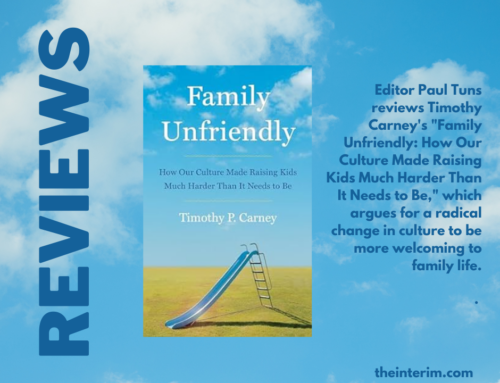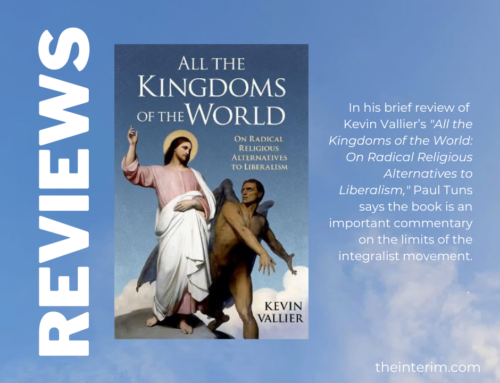Paul Tuns
From the editor’s desk:
Cardus, a Canadian think tank, released a report, “Needs Improvement: How Public Schools Teach About Religion,” authored by Andrew P.W. Bennett. The study looked at how religion is taught in elementary and secondary schools in British Columbia, Manitoba, Nova Scotia, and Ontario. It found that approaches varied, with Ontario being a “stand-out example of a more expansive engagement with religion” while other curricula tended to view religion “as a social phenomenon, to be approached by the detached observer” – that is, they were taught through the lens of social science rather than philosophy or theology. Bennett’s most interesting finding, however, was how “Indigenous Spirituality” was taught in the four provinces, invariably preferring the term “spirituality” rather than religion. In B.C., for example, Bennett said “First Nations spirituality is presented in an affirming manner as spiritual well-being which is negatively affected by colonialism.” Bennett says that there is no exploration of how indigenous spirituality co-exists with other religious beliefs. In the Manitoba curricula, native spiritualism is juxtaposed with the Christianity of “settlers” and the former always presented more favourably than the latter. Yet, Bennett notes that according to Statistics Canada, in 2011, nearly 64 per cent of indigenous Canadians self-identify their spirituality/religion as Christian while just 4.5 per cent identify as “Traditional (Aboriginal) Spirituality.” Bennett says many indigenous Canadians integrate their Christianity into their native culture but these “realities” are not conveyed in school curricula.
**
The (London) Times reported that gender and sexuality education activist Sacha Coward said it can be “hard for us to look at the 8th and 11th centuries in Scotland without a strong cisgender and heterosexual bias” and therefore “queer theory is an important part of archeology and can help us understand the complexity and diversity of past societies.” He added “it is possible that we are talking about people who would today identify as transgender or nonbinary.” For good measure, he said that some Vikings were transgender because skeletal remains show some warriors were female. It is more likely that the female skeletal remains of Viking warriors were women and not women masquerading as men. I would suggest it is Mr. Coward who is projecting biases on the past. I also wonder how we know that these female warriors were women if womanhood is mutable as queer and trans theory proclaims it to be. Or is the DNA evidence that they so conveniently want to ignore in 2022 telling us something important about people who lived many centuries ago?
**
There were many reports about a pandemic baby bust in the early days of COVID-19, but preliminary data from the United States suggests the decline in births was not as large as initially expected. Early in the pandemic, the Brookings Institute reckoned that the health crisis and accompanying economic uncertainty would lead to 300,000-500,000 fewer births in the United States in 2021; in December 2021, they updated their estimates to predict 60,000 fewer births. Yet according to the Centers for Disease Control and Prevention’s National Center for Health Statistics, the U.S. experienced a drop of just 7,000 births in the first nine months of 2021 compared to the same period the year before. The CDC’s health statistics take into account conceptions that occurred between April and December 2020, the first year of the pandemic. The Wall Street Journal reported “starting in June 2021, monthly births began to show consistent gains over their year-earlier levels, which reflect pre-pandemic conceptions, and that mostly offset declines in the first two months of 2021, the data show.” It should be noted that these numbers are provisional estimates and that final figures for 2021 are not expected until later this year. This may be the silver lining on the cloud of persistently declining fertility rates and the slight uptick in 2021 follows the lowest number of babies born in the U.S. in four decades in 2020. The average number of babies a woman will have in her lifetime in the U.S. stands at 1.64, the lowest rate on record – and well below the 2.1 replacement fertility rate. The low fertility couples with lower than usual immigration meant that the U.S. population grew by just 0.1 per cent, the lowest rate in recorded American history.
**
The Washington Post had an article in their lifestyle section about a “throuple” or “triad” – essentially a polygamous relationship among a married man and woman and their girlfriend – a girlfriend to both the husband and wife in Chattanooga, Tennessee. The Post’s reporter, Karen Heller, endeavours to make the relationship both normal and boring, but the grouping has enough of a novelty to attract some 263,000 TikTok followers. (TikTok is a social media platform and I did not venture to see what videos were on offer.) Heller says of the “throuple” – a neologism that combines three-person and couple – “it’s actually kind of boring” describing the daily routine of laundry and paying bills. One wonders why the normal and boring warrant a story in the lifestyle section; when I went to journalism school, the fact that ordinary people living ordinary lives was not worth reporting was drilled into us. The presentation of multi-partner relationships – the story also references a “quad” – as school, the fact that ordinary people living ordinary lives was not worth reporting was drilled into us. The presentation of multi-partner relationships – the story also references a “quad” – as normal is gaslighting, which is the manipulation intended to have someone question reality. There is a long history of entertainment and journalism reporting on the perverted novelty to stoke curiosity followed by the presentation of the perversion as normal (later followed by punishing those who do not go along with the game). In the last two decades there have been numerous entertainment offerings showing polygamy: HBO’s Big Love and “reality TV” such as Sister Wives, My Five Wives, and Seeking Sister Wife. They were on-going series that garnered more favorable coverage than documentaries such as Prophet’s Prey. These shows did for polygamy what the odd gay character in 1970s and 1980s television shows and later the series Will and Grace did for homosexuals. Heller tries to convince readers that polygamy is actually not all that novel, noting that polyamory was practiced in Biblical times forgetting to mention that is condemned and full of problems. For what it is worth, the Chattanooga threesome is planning a “Troupledom” ceremony later this year. No doubt, we will be seeing these announced with increasing frequency in the wedding notice section of the newspaper.
**
Another form of decadence gaining popularity did not require the efforts of the entertainment and news industries propaganda efforts to popularize: gambling. But it did need to break down taboos and normalize the activity, which began with trips to Las Vegas and Atlantic City and the creation of state-run lotteries. The problem is that it did not stop with vacations to exotic locales or small-scale weekly purchases of lottery tickets. Super Bowl Sunday is accompanied by figures of the estimated billions upon billions of dollars that are wagered both legally through casinos and lotteries and in the gray area of private betting. In 1973, Irving Kristol wrote in the Wall Street Journal about the growing popularity of gambling that was being foisted upon the public by governments. “When government gets into the gambling business,” Kristol warned 49 years ago, “it necessarily assumes the responsibilities for seeing that this business grows and prospers.” In effect, Kristol wrote, “it proclaims that gambling is not a necessary evil but an inherently good thing.” That is especially true when the state funnels some of the proceeds to worthy causes such as schools and hospitals. New York Times columnist Ross Douthat had a wonderful essay in that paper last month about the growth industry that is legal betting and he is deeply concerned about the normalizing of gambling. He noted that the growing ease of gambling “will separate many millions of non-wealthy Americans from their money, very often harmlessly but in some cases disastrously, with a lot of sustainable-or-are-they gambling addictions falling somewhere between.” Douthat blames “our inability to take a cautious step or two down a slippery slope without tobogganing to the bottom” because of “our fatal impulse toward consistency.” He notes that once something is permitted in some cases, the modern mind and liberal state stubbornly refuse to make distinctions and therefore once the door is opened in some cases, “it became inevitable that restrictions would eventually crumble on a much larger scale.” Douthat argues that “some limited permission was always necessary” because it is a “harmless vice for many people” and that over-policing has its problems, too. But once gambling is easier, it will become more accessible to more people and then the profit incentives lead companies and governments to find new ways to hook people. The problem is less gambling, Douthat argues, than society’s inability “to be able to say this far and no farther, even if the limiting principle is somewhat arbitrary.” Gambling is like pornography in that it is not easy to draw the line between, say, the publication of smutty novels such as Lolita and the full-out pornography of Penthouse, or between the purchase of a pornographic magazine and the ease of access to pornographic websites. We must learn to make distinctions once again, regain scruples and social regulation, and determine the lines we draw to uphold a modicum of necessary protection from our baser instincts.




